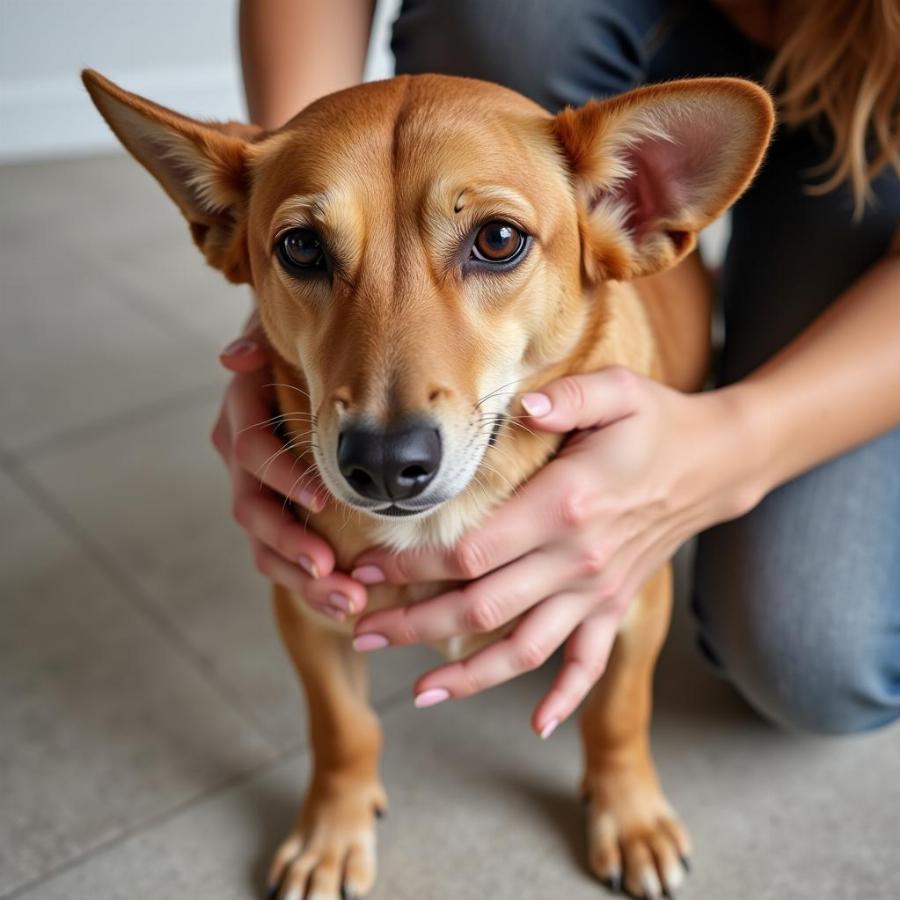Histiocytomas in dogs are common, benign skin tumors that often appear as small, raised, red bumps, sometimes with a hairless center. While the term “histiocytoma dog home treatment” is often searched online, it’s crucial to understand that true home treatment is not recommended. Observing the growth and consulting with your veterinarian is the best approach. Though histiocytomas often regress on their own, professional guidance is essential to ensure proper diagnosis and rule out other, potentially more serious conditions.
Understanding Histiocytomas in Dogs
Histiocytomas are primarily found in young dogs, typically under three years old. Breeds like Bulldogs, Boxers, and Boston Terriers seem to be more predisposed. These tumors originate from Langerhans cells, which are part of the dog’s immune system. While they can appear anywhere on the body, they’re frequently found on the head, legs, and ears. Often, owners mistake them for insect bites or other minor skin irritations.
What makes histiocytomas unique is their tendency to regress spontaneously, typically within 2-3 months. This self-resolution is why some owners might consider home remedies. However, without veterinary confirmation, you cannot be certain the growth is indeed a histiocytoma. Misdiagnosis can lead to delayed treatment for more serious conditions.
When Should You See a Vet About a Suspected Histiocytoma?
While many histiocytomas resolve on their own, a veterinary visit is essential for accurate diagnosis. If you notice any unusual lump or bump on your dog, schedule an appointment with your veterinarian. They can perform a fine-needle aspiration or biopsy to confirm the diagnosis and rule out other conditions like mast cell tumors, which require different treatment.
Here are some specific scenarios that warrant immediate veterinary attention:
- The growth grows rapidly.
- The growth ulcerates or bleeds.
- The growth seems to bother your dog (itching, licking, scratching).
- The growth persists for longer than three months.
Managing Histiocytoma in Dogs: Veterinary Guidance is Key
While there’s no specific “histiocytoma dog home treatment” to cure the tumor, your veterinarian might suggest supportive measures if the growth is confirmed as a histiocytoma. This could include:
- Monitoring: Regularly checking the growth’s size and appearance.
- Preventing secondary infection: If the histiocytoma is ulcerated, your veterinarian may prescribe topical antibiotics to prevent infection.
Why “Home Remedies” for Histiocytoma are Discouraged
Searching for “histiocytoma dog home treatment” often leads to various home remedies suggested online. However, applying any substance to a skin growth without veterinary approval can be risky. It could irritate the area, delay proper treatment, or even mask underlying conditions.
What to Expect at the Vet’s Office
Your veterinarian will likely perform a physical exam and possibly a fine-needle aspirate or biopsy to diagnose the lump. If confirmed as a histiocytoma, they may recommend monitoring and possibly topical medication if needed.
Dr. Emily Carter, DVM, a renowned veterinary dermatologist, advises, “While the internet can be a valuable resource, it’s crucial to remember that every dog is different. What might work for one dog might not be appropriate for another. Consulting with your veterinarian is always the best course of action.”
Can Histiocytomas Be Prevented?
Unfortunately, there’s no known way to prevent histiocytomas in dogs. They seem to arise spontaneously and are part of the dog’s immune response. Regularly checking your dog’s skin for any unusual growths is the best approach to early detection and appropriate management.
 Owner Checking Dog's Skin
Owner Checking Dog's Skin
Conclusion
While the desire for “histiocytoma dog home treatment” is understandable, prioritizing professional veterinary guidance is paramount. Although histiocytomas often resolve independently, proper diagnosis is crucial. Contact your veterinarian if you notice any new skin growths on your dog. Remember, early detection and professional advice are key to ensuring your furry friend’s health and well-being.
FAQ
- What does a histiocytoma look like on a dog? They typically appear as small, raised, red, and sometimes hairless bumps.
- Are histiocytomas painful for dogs? They’re usually not painful unless ulcerated or infected.
- How long does it take for a histiocytoma to go away? Most regress within 2-3 months.
- Can histiocytomas come back? It’s rare for them to recur in the same location.
- Are histiocytomas contagious? No, they are not contagious to other animals or humans.
- What if the growth doesn’t go away? Consult your veterinarian, as it might not be a histiocytoma.
- Are there any dog lumps pictures I can look at for comparison? Check out dog lumps pictures and tumor on dogs paw pictures for visual references. You can also see pictures of sebaceous cysts in dogs or learn about big skin tag on dog for other potential skin issues.
Related Questions and Further Reading
- What other types of skin tumors can dogs get?
- What are the signs of skin cancer in dogs?
- How can I keep my dog’s skin healthy?
Beaut Dogs is your go-to resource for all things related to dog care. We offer reliable and in-depth information about the canine world, from breed-specific details to health and nutrition advice. For any further questions or assistance, please contact us via Email at [email protected]. Beaut Dogs is dedicated to providing accurate and helpful information to ensure the well-being of your beloved canine companions. Visit us at https://beautdogs.com for more valuable insights.